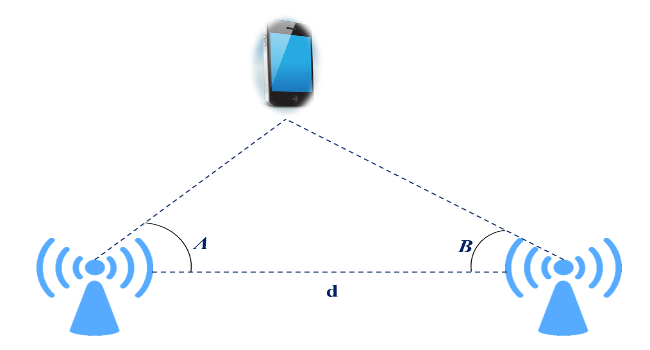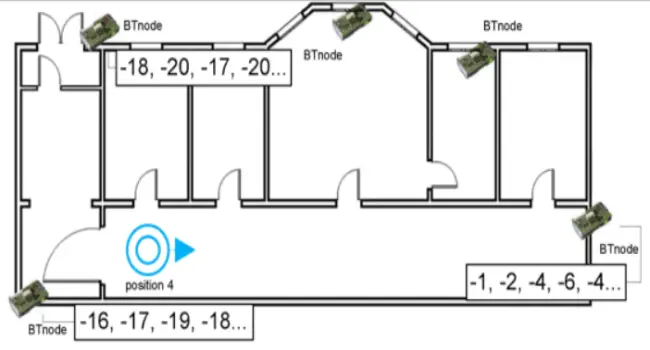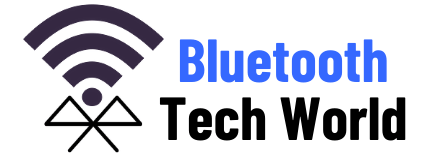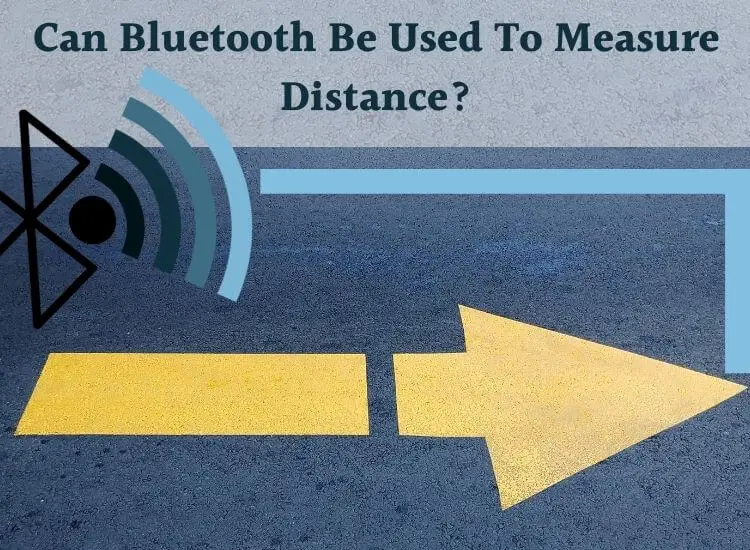“Bluetooth should be able to measure distance if it can connect two devices”, I said to myself. But can Bluetooth be used to measure distance accurately? To answer that, I did my research on the internet to gather some information, and this is what I found;
Bluetooth can be used to measure distance by inferring it mostly on a received signal strength indicator (RSSI). While Bluetooth devices are not usually designed with a function to measure distance, various modifications can be made to them for them to do exactly that.
The approach is not as simple as you may perceive it. The popular approach is triangulation. Other methods are under study, and some are yet to be discovered.
Also, some challenges come with using Bluetooth to estimate distance which I will share in a moment.
Ways To Measure Distance With Bluetooth
Currently, there isn’t one way to measure distance with your Bluetooth. This aspect of Bluetooth technology is still under exploration. The interest in this function is mainly due to the failure of the GPS to work effectively in an indoor environment.
And since Bluetooth can pass through walls, its potential is exploited, which I will share with you in a moment. From what I gathered in my research, you can use Bluetooth to measure distance in the following ways;
Ranging – Estimating Distance from Correlations with Bluetooth Property
Ranging is a procedure used to compute the distance between two Bluetooth devices without consideration of the angle of separation. It’s a common approach largely used to accomplish distance measurement. The popular methods are based on the received signal strength and time of flight.
The two devices have to be within Bluetooth range for any of the methods. With the received signal strength, you measure the distance of Bluetooth A from B by using the Bluetooth signal strength that A receives from B.
The signal strength is inferred from the distance of their separation using the relation;
d=20^(RSSI+a)
The a is a factor to offset the maximum received signal. While this approach is simple and straightforward, it only works well in an outdoor environment. This is because, in the indoor environment, obstacles such as walls, tables, chairs, other radio frequencies, and even people in the place are not factored in the formula. This introduces errors in the estimation.
What you can do then is use the time of flight which is how long it took for Bluetooth A to receive a signal from Bluetooth B. This sounds interesting, however, it requires accurate time measurement hardware on Bluetooth devices which most lack.
Using the Principle of Triangulation
With this method, you have to be good at coordinating and geometry. It reminds me of high school mathematics :). Unlike ranging, you can determine the distance separating Bluetooth devices by using the angle of incoming signals. It involves three Bluetooth devices, two of which serve as the base node.

This means you have to know the coordinates of the base node Bluetooth devices, which will be your reference to determine the location of the third device you’re interested in. You’re not going to get a direct distance measurement.
You’ll calculate the distance with a mathematical formula related to triangles using the coordinates and the angles obtained.
Obviously, you’ll need a transmitter or receiver with some level of Bluetooth signal directionality.
Fingerprinting
This approach is popularly used in WiFi-based systems but can be adopted for Bluetooth since they all have the RSSI function. You can’t directly measure distance with this, but you can use it with another formula.
In fingerprinting, the device’s signal strength is read and compared with a pre-determined database of locations, which gives you the best match. It’s known to provide an accuracy of 3 m and can be achieved with 80% precision,
So instead of inferring locations on the signal strength, you can either implement ranging or triangulation to compute the distance.
Artificial Neural Network
After Google’s AlphaGo beats the former Go champion player, Lee Se-dol, artificial neural networks have attracted attraction in other application fields. For the paper I came across, an artificial neural network was used to estimate the position of an incoming Bluetooth signal using RSSI and user orientation.
The authors used an indoor environment for this study with several Bluetooth base nodes. With multiple neural network architectures developed for the nodes, it predicts the position of an incoming Bluetooth signal.

A compass that comes with the setup provides information about the user’s orientation. With that, the appropriate neural network is selected and used with the RSSI recorded to estimate the object’s position.
The other approach they used in predicting position is to pass the neural network’s output to a navigation tree where a lookup is done to infer it. While this doesn’t give you direct distance measurement, you can use the orientation and the RSSI value to estimate it.
All the approaches shared sound interesting. Most of them are still under exploration to deal with the challenges that come with using Bluetooth for measurement.
Things To Consider When Measuring Distance With Bluetooth
Bluetooth Signal Strength
Most of the distance-measuring approaches with Bluetooth use the RSSI for estimation. While that appears to be the easiest and readily available option, it isn’t a good indicator of the distance between two connected Bluetooth devices.
This is because the signal strength can vary under different conditions, which may not represent the distance.
It’s a matter of the environment you’re dealing with. You have to answer questions like; is someone between the devices? What’s the person’s orientation? What’s the path loss? Is there any radio frequency reflecting surfaces?
Dealing with these questions will help you minimize errors. So you have all these variables to deal with, which makes the accuracy for longer distance estimation low.
Multi-path Interference
While you try to estimate the distance from another Bluetooth device, other radio frequencies will likely interfere with the signal. When you have those interruptions, it’s likely that you’re introducing errors into your measurement.
The farther the devices are apart and the more radio frequencies between them, the higher your chances of sacrificing accuracy.
Radiofrequency devices such as wireless garage door openers, wireless microphones, remote control devices, cordless telephones, wireless alarm systems, WiFi transmitters, and other Bluetooth devices can all interfere with your measurement.
Bluetooth power consumption
How is this related to measuring the distance with Bluetooth? It’s got to do with the Bluetooth range, the distance you want to measure, and the version of Bluetooth you’re using. Long-range Bluetooth devices usually come with a Bluetooth power tradeoff.
Using Bluetooth for measuring long distances will require a long-range version. And that has to do with the power for transmission. Fortunately, we have Bluetooth Low Energy in the system, which is suitable for this purpose.
It provides a good balance of range and power consumption. With the new Bluetooth low energy, you should be able to handle a considerable distance.
Line of Sight
You can’t expect to record the same distance when there is no line of sight between Bluetooth devices. This has to do with the orientation of the Bluetooth devices and physical things such as crowds, indoors, and behind shelves, getting between them.
When there’s a line of sight, the accuracy of measurement can improve.
You can use Bluetooth to measure distance. However, you have all the above challenges to deal with. You may wonder-can Bluetooth distance measurement ever be accurate?
How Accurate Is Bluetooth Distance Measurement?
The accuracy of Bluetooth distance measurement for an indoor environment is generally low. Bluetooth distance measurement is usually less than a meter with precisions around 80%-90%. This is expected to increase as Bluetooth technology advances with time.
It is affected by the environment and the range within which you’re considering the measurement. They are major factors that affect the accuracy of Bluetooth distance measurement.
However, with some modifications and trials, you can make adjustments to improve it. For outdoor measurements, you can have an accuracy of fewer than 100 m with a precision of around 90%, depending on the things in your environment and the range of your Bluetooth device.
Conclusion
Measuring distance with Bluetooth is possible, especially for indoor environments where GPS is invalid. It has become the research interest for most Bluetooth technology companies because the potential looks great.
With Bluetooth 5, which has revolutionized the technology, I believe a time will come when most distance-measuring challenges will be a thing of the past. What do you think?
Have you tried using Bluetooth to measure distance? What were your challenges, and how did you overcome them? Do you think Bluetooth can be very accurate to trust?
Let me know your thoughts in the comment below, and I’ll be glad to connect with you. If you have experience measuring distances with Bluetooth, feel free to share. Thank you!


While I have never personally used Bluetooth to measure distance, the topic is very intriguing! It does seem like fairly simple mathematics to work out a rough distance, but this leaves me with questions of application. I feel like a positive application of measuring distance with Bluetooth would be if you’ve lost a device? I’m not sure if that actually works. I’m not great at tech, but I think that could be helpful. The application my paranoid mind is concerned about, though, would be if a hacker or stalker used this method to track someone and rob or kidnap them. But hey, usually the positives outweigh the negatives. I love a good technological advancement.
Hey Maria,
Glad to have you on my site. As far as it’s about distance measurement it could be used. However, with the current state of Bluetooth technology, that’s going to be difficult. Some of the challenges will be:
1. Range of the Bluetooth device
2. It either the Bluetooth device is turned on all the time or something to trigger it at that time
3. Security factors
For now, I don’t see it to be a suitable option for locating a lost device. There are a number of apps in the system that can do the same thing.
Who would have thought that you can measure distance with Bluetooth? I for sure not. That is why I really enjoyed reading your post about it. I can see how Bluetooth signal strength could be a challenge when doing measurements based on my personal experience with Bluetooth. I often play music on my Bluetooth speaker and if I want to bring it with me into another room in the house, away from my computer, the signal gets weaker or disrupted.
I guess once they eliminate disruptions and improve the accuracy of measurement, we’ll be all using Bluetooth for measuring distance.
That will be a great breakthrough.
I don’t know, this article for the pandemic era is like pure gold, awesome. Everyone needs it as a GPS alternative as a contact trace, even Google and Apple have concerned about this.
Hello! My group is planning to use Bluetooth to measure the proximity of two Bluetooth devices and will alarm when the distance preference is not met. This is to ensure social distancing is always present. But we are having a hard time figuring out how are we going to implement it and we are required to use VBA
I’m not sure if I understand clearly the area of your implementation issue
Hello, I think this idea has many uses in the the industry. I’m looking myself for a device that can measure the distance between two Bluetooth devices (Base and Mover) and alert one of them when Mover it’s out of range. Important would be accuracy and availability to use more devices in an area.
Hi Octavio,
You’re absolutely right! There are several applications in the industry that this idea can be utilized.